
GNLW363CG is a Dual Motor Decanter Centrifuge. It is the latest design high speed centrifuge designed and made by world leading manufacturer: GN Solids Control. The centrifuge is widely used in worldwide drilling rig job site.
GNLW363 is a 14 inch decanter centrifuge. GN offers 2 standard 14 inch centrifuge for customers’ option. High standard GNLW363CG is made from top ranking materials, to compete with U.S and European brand. Economic standard GNLW363CD decanter centrifuge is with the same design with high standard. The difference is that, some parts is chose from economic standard, but the material standard is still higher than normal Chinese brand.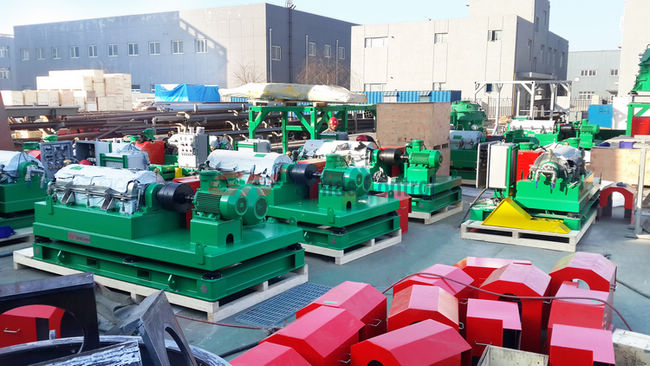
Feb. is the New year month for all Chinese people. But it is one of the most busy month for GN. Besides 5 tank systems and other equipment, GN Solids Control dispatched 19 sets decanter centrifuge in this month.
1) 16 GNLW363CG dual Motor Decanter Centrifuge together with 20 pumps for an Africa customer.
It is only the first batch of the shipment. Another half (16 centrifuges and 20 pumps) will be dispatched weeks later.
The customer order the same model GNLW363CG centrifuge, with fixed speed control. GN offer different size of pulley and belt for different fixed speed. So customer only need to change pulley and belt, customer can get lower speed, high speed and middle speed for the same one centrifuge.
The 32 sets centrifuge will be used for barite recovery with lower speed, and for fine solids recovery with high speed.
2) 1 set GNLW363CG dual Motor Decanter Centrifuge together with 1 set vertical cuttings dryer dispatched for Africa mud service company.
They will be used for drilling waste management. With its patent design, GN vertical cuttings dryer GNCD930C can be used to treat both water base mud and water base mud. Even U.S and European dryers, they cannot treat water base mud.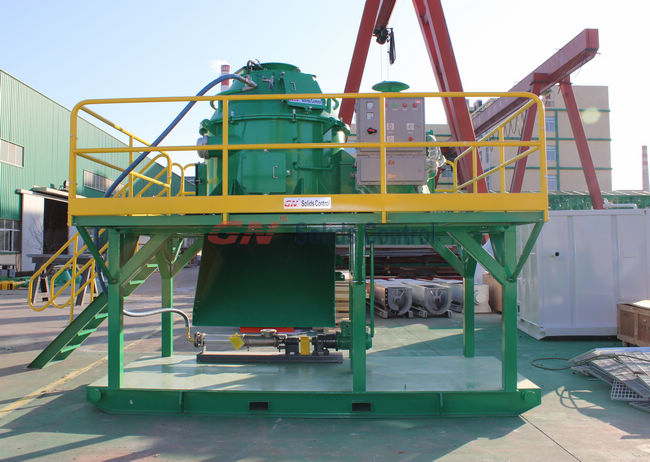
3) 2 sets GNLW363CG dual Motor Decanter Centrifuge together screw conveyer and dewatering unit dispatched for a Middle east drilling company. The end user is a National drilling company. They saw our equipment running for their rigs, so appointed to buy from GN for their new projects.
Furthermore, totally another 27 sets GNLW363CG dual Motor Decanter Centrifuge will be dispatched for overseas customers in March.
For more information of GN Solids Control equipment, services and systems, welcome you contact GN group freely.
- Details
-
Published: 28 February 2015
The Lunar New Year is the real year end and start for all Chinese people. And it is the most important festival for all Chinese. 2014 is a productive year for all GN people. For thanks GN people for the past year 2014, GN Solids Control awarded 4 SUV and 2 cars for outstanding employees, and over 60 ea different standard bonus.
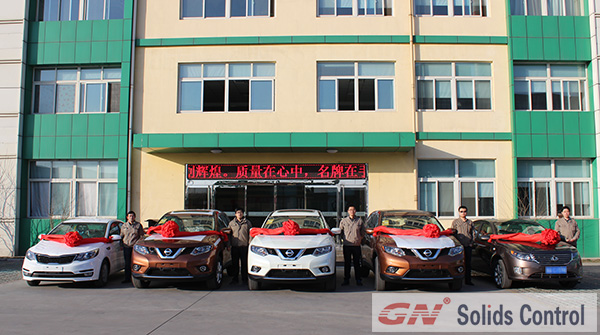
GN new year holiday will start from 13th Feb. ~ 26th Feb.. The office and warehouse will be closed during that time. For urgent, you can contact GN Solids America and purchase from GN Solids America directly. We have storage in Houston for normal solids control and drilling waste management equipment, and some normal spare parts, like hydrocyclones, shaker screens.
GN Solids America is the 1rst China solids control brand having warehouse and base in Houston, USA. GN offers sales service and rental services in U.S.A market with solids control and drilling waste management equipment. Below is part of equipment now in stock in GN Houston warehouse:
1) Solids Control linear motion shale shaker and drilling waste management high G drying shaker.
2) 14’’ normal size decanter centrifuge, 18’’ and 22’’ big bowl centrifuge for drilling waste management and dewatering 14’’ decanter centrifuge is GN superstar products. Every year, GN sold over 150 sets this model to international market. Almost all is international high standard compete with U.S and European brand with top quality. A fewer sets economic standard compete with normal Chinese brand with good price and better quality.
3) Jet mud mixer for solids control mud mixing system
4) Vertical cuttings dryer for drilling waste management. GN drilling waste management dryer can treat OBM, WBM and SBM.
5) Some normal spare parts for GN equipment or equivalent spare parts interchangeable with other brand.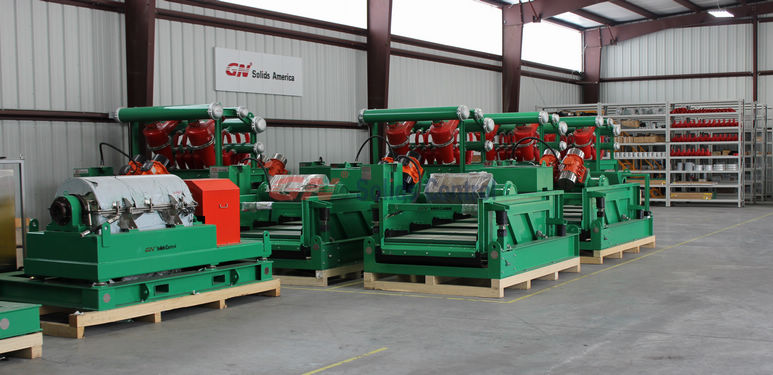
If you want rental service in U.S.A, welcome you come and visit GN Solids America at 6710 Windfern Road, Houston, TX 77040, USA. You can check the available stock in GN warehouse by yourself. Furthermore, GN will show its advanced design solids control and drilling waste management equipment is Beijing CIPPE oil show in March. Welcome you come and visit.
- Details
-
Published: 12 February 2015
GN Solids Control is a specialized manufacturer for the drilling mud solids control and drilling waste cuttings equipment. The shale shaker is one of GN’s main products. For this main product, at this time all the model GN’s provided is the linear motion vibration mode. As per the requirement coming from different industry and the customer’s preference, GN’s shale shaker is classified by the treating capacity and application.
GN’s shale shaker is classified as 200GPM, 500GPM and 600GPM. The smallest model is always be used in the compact system for the job site with limited location area. GN’s 600GPM model could be used in both the common solids control and waste management system. When talking about the slurry feeding type of GN high G force drying shaker, there are 3 types used for different application. The 3 types of the feeder box are the top located design; back located design and hopper designed. For the top located design feeder box, the shale shaker is often proposed to use in the mud recycling system for the HDD projects. As the mud tank in HDD are always narrow, so there is no enough space of the tank surface to locate the shale shaker. In HDD project, the drilling mud are always fed to the shale shaker through the pump, the drilling mud come to the screen with very low pressure, so the drilling mud would come to the screen directly from the top located feeder box. While in the oil drilling projects, the drilling mud always comes out from the drilling hole with high pressure. Thus there will be a buffer box to reduce the high pressure of the drilling mud, the feeder box is designed like an “nâ€, and the drilling fluids need overflow into the shaker deck.
For the hopper design feeder box, it is specially used for drilling waste cuttings dryer system. As the waste cuttings are always very thick, and the fluidity is not as good as the drilling fluids. When delivered to the drying shaker by the screw conveyor, the waste cuttings have to get into the shaker via a large opening feeder box. For this type hopper, it is easy to let the cuttings get in and performance would be very well.
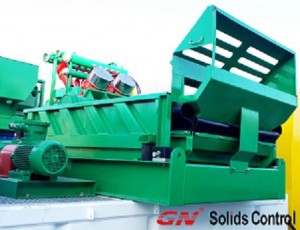
- Details
-
Published: 12 February 2015
Screw conveyer also called auger. It is widely used in building industry, chemical industry, environmental protection, medicine, metallurgy, food industry, and so on. U-trough shaft screw conveyer is the most common model been used to transfer drilling cuttings in drilling waste management field. It can be feed or discharged at different section or port, very flexible in use. U-shaped conveyor trough is closed, and the cover can be opened. The cover material can be steel plate or good sealing, or Galvanized steel grating plate for easy observation. Depends on the diameter of the auger impeller, there are 12inch screw conveyer, 14 inch screw conveyer, 16 inch screw conveyer and 18 inch screw conveyer.
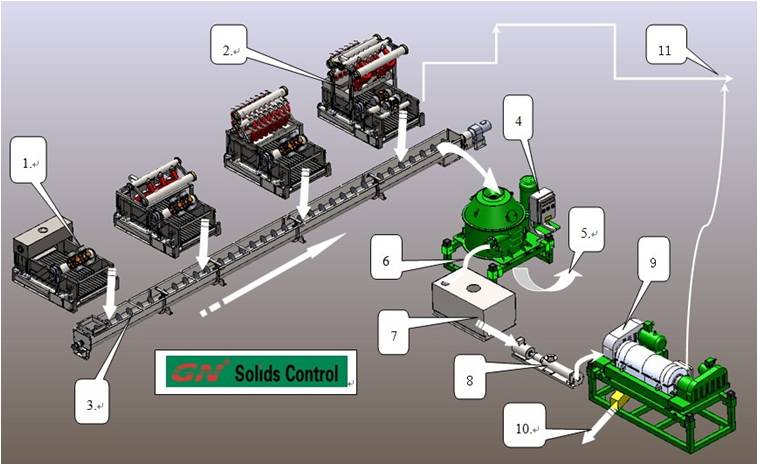
Below table is parameters for common model screw conveyer
|
Model |
Screw Diameter (Inch) |
Screw Length |
Capacity (Ton/Hour) |
Motor |
Speed (Rpm) |
Weight |
Dimension: L×W×H(mm) |
|
GNSC12A-24 |
12 |
24 |
20 |
60 |
1426 |
9150×450×600 |
|
|
GNSC12A-36 |
12 |
36 |
20 |
1855 |
12950×450×600 |
||
|
GNSC12A-48 |
12 |
48 |
20 |
11(15HP) |
2318 |
16750×450×600 |
|
|
GNSC14A-24 |
14 |
24 |
30 |
1515 |
9200×485×650 |
||
|
GNSC14A-36 |
14 |
36 |
30 |
11(15HP) |
2028 |
13000×485×650 |
|
|
GNSC14A-48 |
14 |
48 |
30 |
15(20HP) |
2549 |
16800×485×650 |
|
|
GNSC16A-24 |
16 |
24 |
45 |
11(15HP) |
1668 |
9200×545×680 |
|
|
GNSC16A-36 |
16 |
36 |
45 |
15(20HP) |
2269 |
13050×545×680 |
|
|
GNSC16A-48 |
16 |
48 |
45 |
3344 |
16950×545×680 |
||
|
Remark: |
Capacity is for horizontal layout at 60RPM |
||||||
Suitable maintenance can extend lifetime of screw conveyer and insure a reliable performance.
Recommend maintenance of screw conveyer for drilling cuttings transfer is as below:
1) Check the gearbox, bearings and other rotating parts, and add lubricating oil periodically
2) Check the screw conveyer impeller periodically, if there is serious wearing, repair and re-weld it
3) Do not use the screw conveyer with overload.
4) If there is abnormal noisy during running, stop the screw conveyer immediately and check the reason.
Applications of drilling cuttings transfer screw conveyer
1) It can be used in level to collect drilling cuttings discharged from solids control mud system, like solids control shale shaker, desander, desilter, mud cleaner. And then another set screw conveyer used to transfer the cuttings to next process equipment.
2) Feeding for vertical cuttings dryer, and then transfer the solid waste discharged from vertical cuttings dryer
3) Transfer drilling cuttings or materials from one place to another
- Details
-
Published: 24 January 2015
There are fixed speed control and variable frequency control for oilfield decanter centrifuge. For fix speed control panel, the centrifuge speed depends on the pulley and belt. The speed is fixed and cannot be change.
For VFD control panel for decanter centrifuge, the centrifuge max. running speed depending on the pulley and belt. Through the control of VFD panel, centrifuge speed can be adjusted from 0 to the max. speed, to from the set min. to the set. max. speed.

There are normally 3 VFD control for decanter centrifuge through the VFD panel.
1) The first VFD is VFD control for main motor. Decanter centrifuge speed can be changed via change the frequency of main drive motor. Most centrifuge suppliers, they will choose VFD control for the main motor drive.
2) The second VFD is VFD control for back drive motor. The function of back drive motor is working together to change the centrifuge differential speed. Differential speed is the main factor to affect separation result.
Formula: Differential speed = Bowl input speed – conveyor input speed / the differential ratio.
The differential ratio speed is a fixed speed, when both Bowl input speed and conveyor input speed changeable, customer is more flexible to get more reasonable differential speed.
3) The third VFD is VFD control for centrifuge feeding pump. Many centrifuge suppliers, they do not choose this VFD control. GN Solids Control company VFD centrifuge with VFD control for centrifuge feeding pump and through PLC system to realize automatic smart control of the centrifuge.
GN Solids Control is China leading manufacturer on oilfield decanter centrifuge. Every year, they sell 200~300 sets different model centrifuges to worldwide countries, like U.S.A, Canada, Poland, Cyprus, Australia, New Zealand, India, Indonesia, Malaysia, Singapore, Thailand, Russia, Kazakhstan, Brazil, Algeria, Nigeria, Egypt, Iran, Iraq, UAE, Yemen, etc…
Besides oilfield decanter centrifuges, GN Solids Control offers linear motion shale shaker, mud cleaner for solids control and vertical cuttings dryer for drilling waste management. For more inquires, welcome you visit GN website or send mail to This email address is being protected from spambots. You need JavaScript enabled to view it. '; document.write(''); document.write(addy_text85356); document.write('<\/a>'); //-->\n This email address is being protected from spambots. You need JavaScript enabled to view it. for inquire.
- Details
-
Published: 17 January 2015
Decanter centrifuge is an important separate machine for both solids control system and drilling waste management process.
GN solids Control is China top manufacturer for oilfield decanter centrifuge. GN makes decanter centrifuge bowl size ranged from 9 inch to 22 inch. To cater for different market customers’ request, GN makes 2 standards decanter centrifuge for oilfield.
1) High standard: It is made per international high standard; all material is chose from top ranking, bearings are chose from top famous brand, Germany SKF.
The high standard decanter centrifuge is used to compete with U.S and European famous brand. Quality reliable and price is much more cost-effective.
2) Economic standard decanter centrifuge: It utilizes latest design, some parts use economic standard material and bearing chose from economic famous brand, like NSK. GN economic standard decanter centrifuge quality is still better than normal China brand, and price is very good.
To thanking for the customers’ support in the past years, GN Solids Control China offers some decanter centrifuge in stock for sales. Centrifuge model list please see below: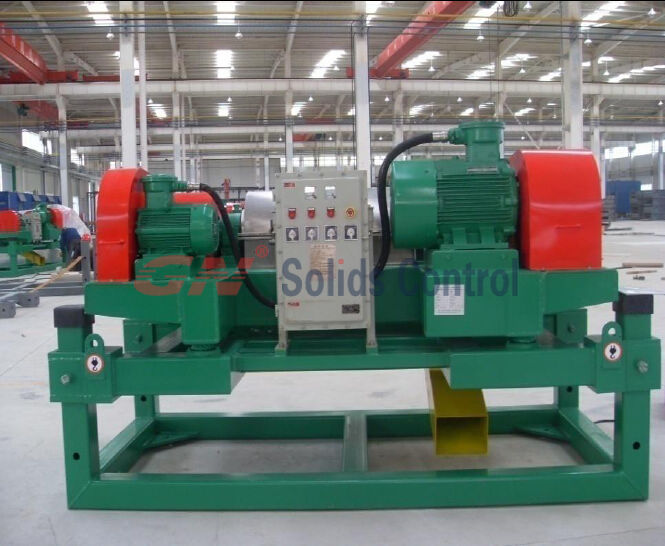
Model 1: GNLW363AG 14inch decanter centrifuge In stock for fast delivery & 25% big discount
Bowl dimension: 14 inch & 50 inch
Max. capacity / typical capacity: 200GPM / 132GPM
Max. speed / typical speed: 3900rpm / 3200rpm
Bowl material: SS316L
Screw protection: tungsten carbon tile
Design time / manufacturing time: 2013 / 2014
Model 2: GNLW363BG 14inch decanter centrifuge In stock for fast delivery
Bowl dimension: 14 inch & 50 inch
Max. capacity / typical capacity: 200GPM / 132GPM
Max. speed / typical speed: 3900rpm / 3200rpm
Bowl material: SS316L
Screw protection: ceramic tile
Design time / manufacturing time: 2014 / 2014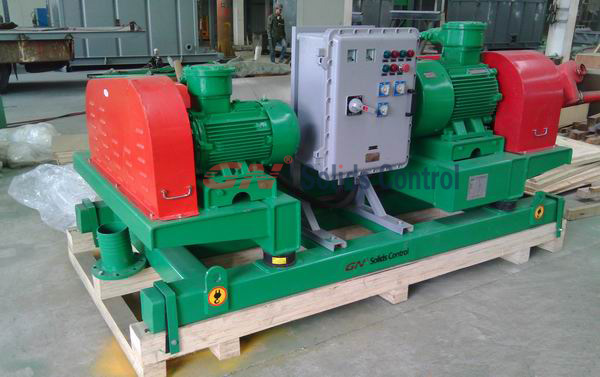
Model 3: GNLW454G 18’’ big bowl centrifuge for waste treatment and waste water treatment
In stock for fast delivery & over 30% big discount
Design time / manufacturing time: 2014 / 2014
More details please refer here: http://www.gnsolidscontrol.com/drilling-fluids/oilfield-decanter-centrifuge-sale-30-discounted-price
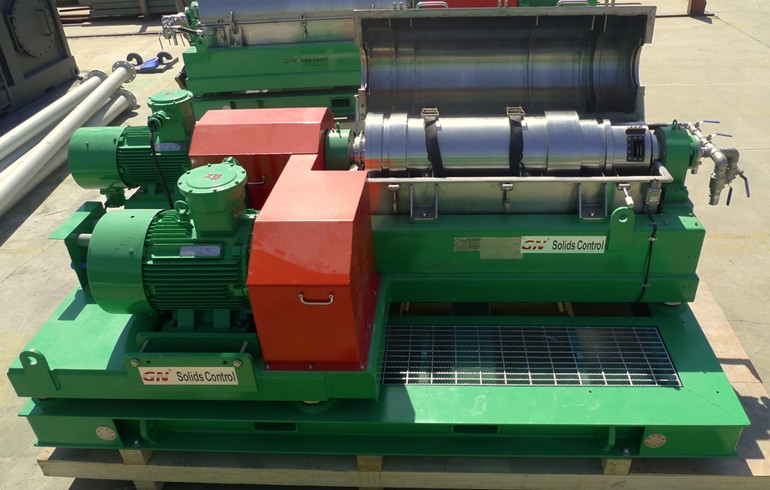
Model 4: GNLW553-VFD big bowl centrifuge Variable frequency control
In stock for fast delivery
Bowl dimension: 22 inch & 71 inch
Max. capacity / typical capacity: 484GPM / 400GPM
Max. speed / typical speed: 3000rpm / 0 ~ 2500rpm
Bowl material: SS316L
Screw protection: tungsten carbon tile
Design time / manufacturing time: 2014 / 2014
- Details
-
Published: 12 January 2015